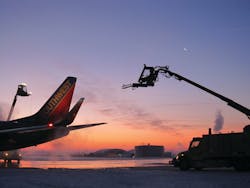Prepping Deicers For Winter
Cold weather and snow may make the holidays seem more magical, but it also creates a host of challenges for those of us in the aviation field.
One of those challenges is safe flight operations. While driving on snow and ice may be hard enough, it wreaks aerodynamic havoc on an aircraft’s control surfaces. In many geographic locations, however, the deicing unit may sit idle for many months out of the year.
Let’s address some of the items that should be inspected before the unit begins the winter tour of duty. First of all, it’s a good idea to give the unit a thorough PMI. Once a basic service and inspection are complete (changing the primary and secondary engine’s oil and filters, fuel filters, etc.), we can then focus on the more specialized components
MAINTENANCE CHECKLIST
The following is a short list of some of the items that should be inspected:
- Inspect the fluid pump(s) for evidence of leaking seals, loose fittings or mounting hardware.
- Inspect all hoses for deterioration, weather cracking, chaffing or leaks.
- Check and clean the line strainer element.
- Check aerial lift operation and all hoses/cables in the hose track.
- Test all safety shutdowns on the unit.
- All safety devices such as lights, horn, beacons, parking brake, chocks and cones should be inspected.
- The condition and charge of the fire extinguisher or fire control system should be checked as well as the date of last certification.
- Hoses and nozzles should be checked for excessive residue build up.
- All electrical panel boxes should be opened and the wiring checked for condition and loose connections. The wire insulation should be checked for deterioration or damage by rodents. Relay contacts should be checked for burns and pitting. Finally, the box itself should be checked for evidence of moisture to ensure it is weatherproof.
- The engine charging system and generator system output should be checked with a multimeter to make sure that they are within spec.
- The fuel system lines and hoses should be checked for both primary and auxiliary engines.
- The dispersing guns should be lubricated with a general purpose lubricating oil.
- Tires should be checked for weather cracking, pressure, and wear.
- Any body scrapes, nicks, or scratches should be lightly sanded and taken care of with touch up paint before the weather gets to wet.
- Windshield wipers should be checked for proper operation and the blades should be replaced.
- The cab heater and defroster should function properly.
- Check all engine belts and hoses for cracks and wear.
- Inspect all wheel lug nuts for tightness and wheel seals for signs of leakage.
- Brake linings should be checked to make sure that the thickness is within spec.
- Also, every 7-10 years the deicer heaters should be removed and disassembled for inspection. If no discrepancy is found, they should be thoroughly cleaned before reassembly.
TEST DRIVE
After the service and inspection are complete, a good test drive should be done. This of course is to ensure the brakes, steering, engine and transmission perform correctly.
Next, the unit can be taken to the deicing pad for a thorough test of all operating systems. Your first deicing operation of the season is not the time to find out that you have a terrible leak or something doesn’t function properly.
Deicing operations typically tend to delay aircraft departures as it is. The operations folks will definitely frown if your unit breaks down, inhibiting operations further.
As usual in our industry, an ounce of prevention goes a long way. We hope that this list of items can assist you with your pre-season inspection of your deicer. As always, consult your specific manufacturer’s manual for complete inspection procedures. Also, don’t hesitate to call them if you have questions as they would surely be happy to help.
Stay warm everyone, and we’ll talk to you in our next installment of Maintenance Matters.
About the authors: Kenneth DeVolpi, manager of GSE and operations, has worked for Matheson for more than four years and has been in the aviation industry for more than 25 years, including 15 years with Northwest Airlines. Jason Chapman works in the company's GSE maintenance department and gained GSE mechanical experience with the U.S. Air Force and has worked in the commercial GSE industry for 12 years.
